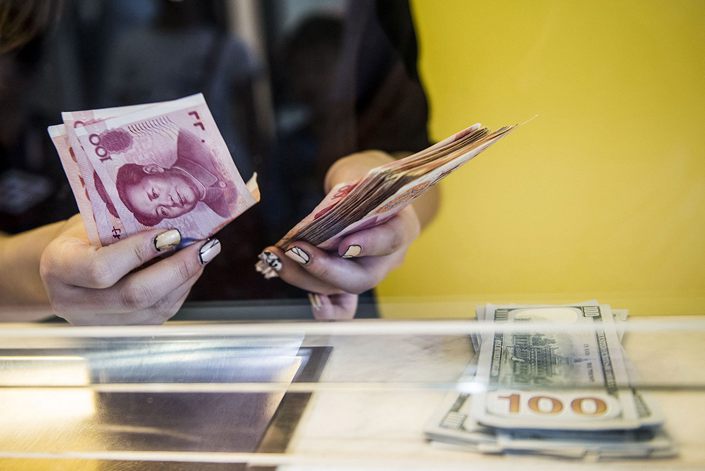In Depth: China’s Bond Market Gets a Reprieve in WMP Overhaul

China’s bond market got a reprieve this month when regulators gave providers of cash wealth management products (WMPs) an extra year to overhaul their wildly popular money market-like offerings under sweeping new rules for the asset management industry.
Industry participants read the delay as a compromise intended to prevent a dramatic selloff in the bond market, even though the revised regulations will drive down the future returns of such products, which are known as cash WMPs. The new rules for such funds take effect Jan. 1, 2023, while operators of other wealth management products need to comply by Jan. 1, 2022.
As of the end of March, Chinese banks issued 25 trillion yuan ($3.9 trillion) of WMPs, about 30% of which were cash funds, according to the China Banking Wealth Management Registration and Depository Center.
Cash WMPs are financial products with short maturities and flexible redemptions that are equivalent to cash. They include short-term deposits with maturities ranging from one day to two weeks, short-term central bank notes, financial bonds and corporate bonds with high credit ratings. Like money market mutual funds, investors can buy and redeem cash WMPs daily.
Cash WMPs are often marketed as delivering returns much higher than ordinary deposit rates, pushing banks to invest in risky assets or extend loans to highly leveraged companies, such as property developers. A chief goal of the government’s new WMP rules is to ban banks from guaranteeing returns on investments, a long-standing practice that encourages investors to dump money into risky, high-yielding assets while expecting state protection if the underlying investments fail, thus posing significant risk to the financial system.
Under the new rules, the WMPs are supposed to be valued on the basis of net assets, and the returns will fluctuate. The net value of financial assets in which bank WMPs invest should be calculated at market value, though exceptions apply to a few types of assets that can use amortized cost.
In July 2018, China’s central bank issued a guideline giving cash WMPs leeway and allowing them to be valued using amortized cost and a shadow pricing method during a transition period. Shadow pricing refers to the practice of accounting for the value of securities based on amortized costs rather than on their assigned market value.
This guideline opened the door for rapid growth of cash WMPs. At the end of 2018, cash WMPs accounted for 10.7% of total WMPs, reaching 2.35 trillion yuan. At the end of 2019, that figure increased to 4.2 trillion yuan. At the end of the first quarter this year, the balance of cash WMPs reached 7.34 trillion yuan, or 29% of the total market.
Whether at home or abroad, cash management products have experienced rapid growth, said a person at a joint-stock bank’s WMP unit. When the industry matures and investor education comes into place, the proportion of such products will slowly decline, the person said.
“It’s not realistic for investors to suddenly accept value fluctuations, or even losses, after expectations of guaranteed returns,” the person said. “We need to build steps in between, from cash products to fixed-income products, then to fixed-income plus products, and guide investors to learn what net asset value is, why it fluctuates and why there may be losses.”
Regulators have sent signals to control the surge in cash WMPs. At the end of 2019, the China Banking and Insurance Regulatory Commission and the People’s Bank of China issued a draft for comments, defining cash WMPs and regulatory requirements for the management of their investment, liquidity and valuation. The draft also required controls on the sale of cash WMPs valued at amortized cost.
Many financial institutions opposed the draft, arguing that regulators should consider the difference between bank WMPs and money market funds based on investor type, sales channels and taxation and should ease certain requirements, including a longer transition period.
When the final rules were issued June 11, banks found few changes from the draft except that the transition would last through the end of 2022. Many industry participants said the delay amounts to a compromise taking into account external circumstances and opposition from multiple parties.
Another major change in the rules is an increase in the total proportion of cash WMPs’ investments in deposits at the same AAA-rated bank and interbank certificates of deposit to as much as 20% from 10% in the draft.
“Even though the main requirements are not eased, the industry is given enough rectification time, so the short-term shock will be limited,” a person at one WMP company said.
Regulators said the one-year extension of the transition will help stabilize market expectations, eliminate uncertainty and prevent banks from selling assets in a concentrated way before the end of the transition period.
Quarterly data released by some banks show that their cash WMPs mainly invest in short-term bonds, banks’ perpetual bonds and longer-term Tier 2 bonds, which are components of banks’ Tier 2 capital, as well as interbank certificates of deposit, Huachuang Securities Co. Ltd. said in a report last month.
Regulators said the banks and WMP providers are allowed to hold their banks’ perpetual bonds and Tier 2 bonds until maturity but cannot use money raised by cash WMPs to invest in new, ineligible assets, meaning such bonds will face no immediate selling pressure. Huachuang analysts projected that the returns on cash WMPs will decline under the new rules.
Contact reporter Denise Jia (huijuanjia@caixin.com) and editor Bob Simison (bobsimison@caixin.com)
Download our app to receive breaking news alerts and read the news on the go.
Get our weekly free Must-Read newsletter.

- MOST POPULAR






